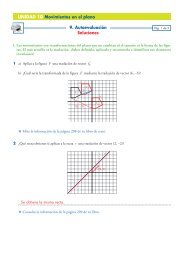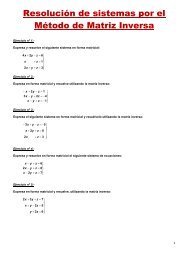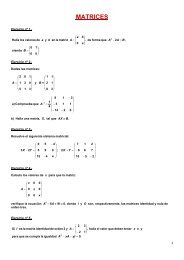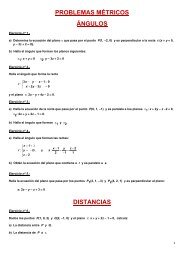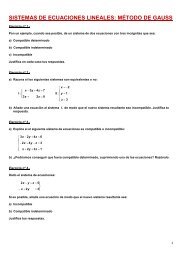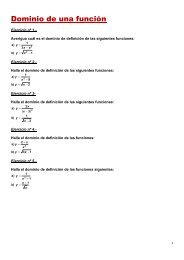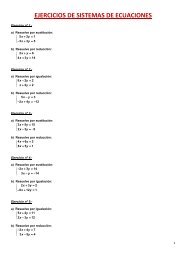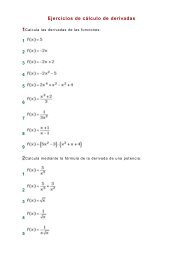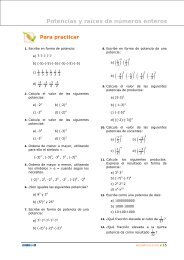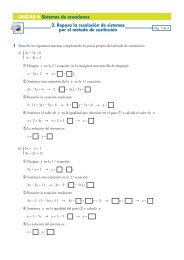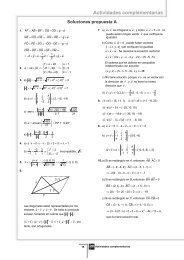Pruebas de Acceso a la Universidad Ejercicios Resueltos ...
Pruebas de Acceso a la Universidad Ejercicios Resueltos ...
Pruebas de Acceso a la Universidad Ejercicios Resueltos ...
Create successful ePaper yourself
Turn your PDF publications into a flip-book with our unique Google optimized e-Paper software.
4 1. Análisis<br />
1.1.4. Se consi<strong>de</strong>ra <strong>la</strong> función real <strong>de</strong> variable real <strong>de</strong>finida por:<br />
- Solución:<br />
f(x) =<br />
3 √ x − 2 si x ≥ 2<br />
x(x − 2) si x < 2<br />
a) (1 punto) Estudiar su continudad y <strong>de</strong>rivabilidad.<br />
b) (1 punto) Hal<strong>la</strong>r <strong>la</strong> ecuacióon cartesiana <strong>de</strong> <strong>la</strong> recta tangente a <strong>la</strong> gráfica<br />
<strong>de</strong> f en el punto (3,1).<br />
(Septiembre 2002)<br />
a) Consi<strong>de</strong>ramos <strong>la</strong>s funciones f1(x) = x(x − 2) y f2(x) = 3√ x − 2, que forman parte <strong>de</strong> <strong>la</strong><br />
<strong>de</strong>finición <strong>de</strong> <strong>la</strong> función f.<br />
Como f1 y f2 son contínuas, f es contínua en los intervalos (−∞, 2) y (2, ∞).<br />
Como f1 y f2 son contínuas, f será contínua en 2 cuando f1(2) = f1(2).<br />
⇒ f es contínua en 2.<br />
Por tanto f es contínua.<br />
f(x) =<br />
<br />
f1(2) = 0<br />
f2(2) = 0<br />
⇒ f1(2) = f2(2)<br />
Como f1 es <strong>de</strong>rivable y f2 es <strong>de</strong>rivable en los intervalos (−∞, 2) y (2, ∞), f es <strong>de</strong>rivable en los<br />
intervalos (−∞, 2) y (2, ∞).<br />
Para estudiar <strong>la</strong> <strong>de</strong>rivabilidad <strong>de</strong> f en el punto 2 recurrimos a <strong>la</strong> <strong>de</strong>finición <strong>de</strong> <strong>de</strong>rivada y<br />
comenzamos por calcu<strong>la</strong>r <strong>la</strong> <strong>de</strong>rivada por <strong>la</strong> <strong>de</strong>recha:<br />
f ′ (2 + ) = lím<br />
h→0 +<br />
f(2 + h) − f(2)<br />
= lím<br />
h<br />
h→0 +<br />
f2(2 + h) − 0<br />
= lím<br />
h<br />
h→0 +<br />
lím<br />
h→0 +<br />
3√ h<br />
h<br />
= lím<br />
h→0 +<br />
f es contínua. f es <strong>de</strong>rivable en (−∞, 2) y (2, ∞).<br />
1<br />
3√ = ∞ ⇒ f no es <strong>de</strong>rivable en 2<br />
h2 b) f(3) = 1, luego efectivamente el punto (3,1) pertenece a <strong>la</strong> gráfica <strong>de</strong> f.<br />
f2(x) = 3√ x − 2 = (x − 2) 1<br />
3 ⇒ f ′<br />
2 = 1<br />
3<br />
La pendiente <strong>de</strong> <strong>la</strong> recta tangente vendrá dada por <strong>la</strong> <strong>de</strong>rivada:<br />
f ′ (3) = f ′<br />
2(3) = 1<br />
3<br />
2 1<br />
(3 − 2)− 3 = 3<br />
(x − 2)− 2<br />
3<br />
3√<br />
2 + h − 2<br />
=<br />
h<br />
La ecuación punto-pendiente <strong>de</strong> <strong>la</strong> recta tangente es y − 1 = 1<br />
1<br />
3 (x − 3) ⇒ y = 3<br />
1.1.5. Dada <strong>la</strong> función:<br />
- Solución:<br />
f(x) = x5 − x 8<br />
1 − x 6<br />
a) (1 punto) Encontrar los puntos <strong>de</strong> discontinuidad <strong>de</strong> f. Determinar razo-<br />
nadamente si alguna <strong>de</strong> <strong>la</strong>s discontinuida<strong>de</strong>s es evitable.<br />
b) (1 punto) Estudiar si f tiene alguna asíntota vertical.<br />
(Junio 2003)



